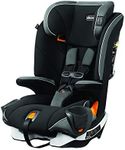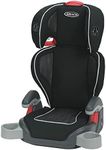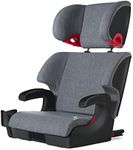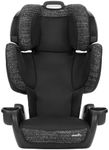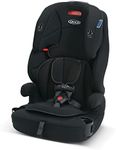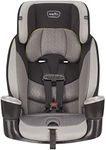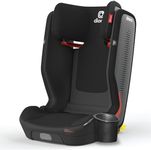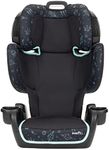Buying Guide for the Best High Back Booster Seats
Choosing the right high-back booster seat is an important step in keeping your child safe and comfortable as they grow out of their forward-facing car seat. High-back boosters provide extra support, help position the seat belt correctly, and often offer added comfort for longer rides. When shopping for a high-back booster, it's important to consider your child's size, your vehicle's compatibility, and the features that will make daily use easier and safer. Understanding the key specifications will help you make a confident and informed choice.Weight and Height LimitsWeight and height limits refer to the minimum and maximum size a child must be to safely use the booster seat. This is crucial because using a seat outside of these limits can compromise safety. Typically, high-back boosters start at around 30-40 pounds and go up to 100-120 pounds, with height limits often between 38 and 60 inches. If your child is on the smaller side, look for a seat with a lower minimum, and if they are taller or heavier, make sure the seat can accommodate them as they grow. Always check your child's current measurements and choose a seat that will last as long as possible within those limits.
Adjustable HeadrestAn adjustable headrest allows you to change the height of the head support as your child grows. This is important for both comfort and safety, as the headrest helps position the seat belt correctly across your child's shoulder. Some seats offer multiple height positions, making it easy to get a good fit. If your child is growing quickly, or if you want a seat that will last several years, look for a booster with a wide range of headrest adjustments.
Side Impact ProtectionSide impact protection refers to the extra padding or structural features on the sides of the booster seat, designed to protect your child’s head and torso in the event of a side collision. This feature is important for added safety, especially if your vehicle has less side protection or if you frequently drive in busy areas. Some boosters have basic padding, while others offer more advanced energy-absorbing materials. If safety is your top concern, prioritize seats with enhanced side impact protection.
Seat Belt Positioning GuidesSeat belt positioning guides are built-in features that help route your vehicle’s seat belt correctly over your child’s shoulder and lap. Proper belt positioning is essential for safety, as it ensures the belt stays in the right place during a crash. Some boosters have simple guides, while others offer more adjustable or clearly marked paths. If your child tends to move around or if you want extra reassurance, look for a seat with easy-to-use and secure belt guides.
LATCH ConnectorsLATCH connectors are attachments that allow you to secure the booster seat to your vehicle’s anchors, keeping the seat in place even when your child isn’t in it. While not required for booster seats, LATCH can make installation easier and prevent the seat from sliding around. If you want a more stable seat or if your vehicle has LATCH anchors, consider a booster with this feature.
Recline OptionsSome high-back boosters offer recline options, allowing you to adjust the angle of the seat for added comfort, especially on long trips or if your vehicle’s seats are more upright. This can help your child rest more comfortably and keep the seat belt in the correct position. If you often take long drives or your child naps in the car, a booster with recline options may be a good fit.
Ease of CleaningEase of cleaning refers to how simple it is to remove and wash the seat cover and padding. Kids can be messy, so a booster with machine-washable covers or wipeable surfaces can save you time and effort. If you anticipate spills or frequent use, prioritize a seat with easy-to-remove and durable fabrics.
